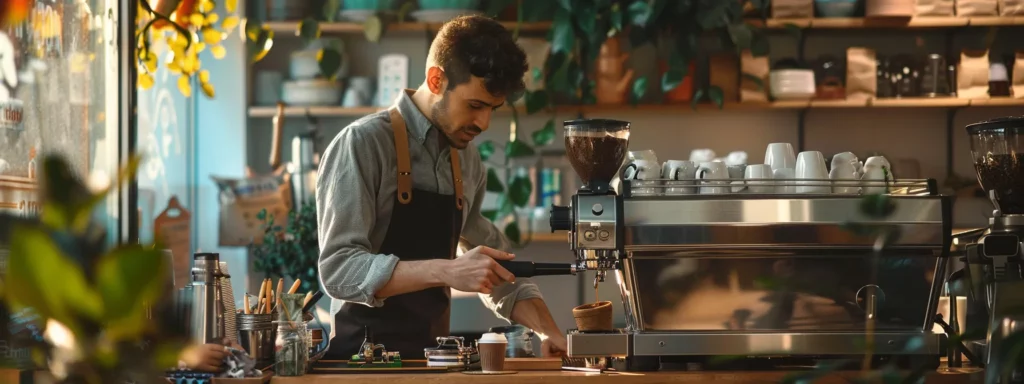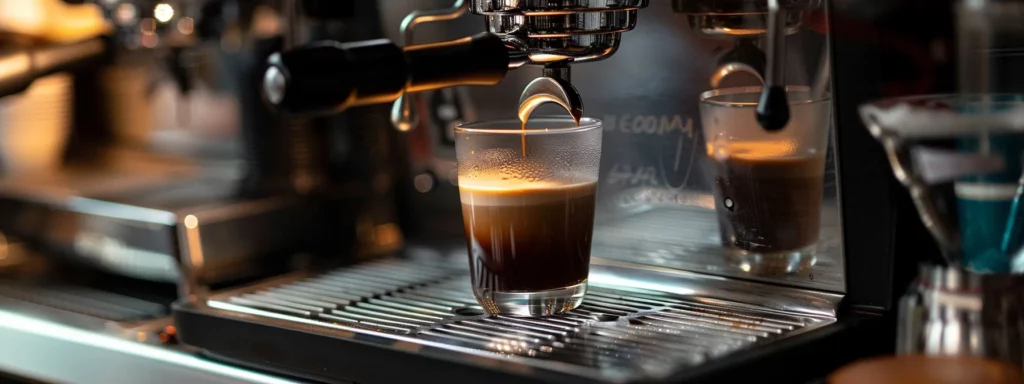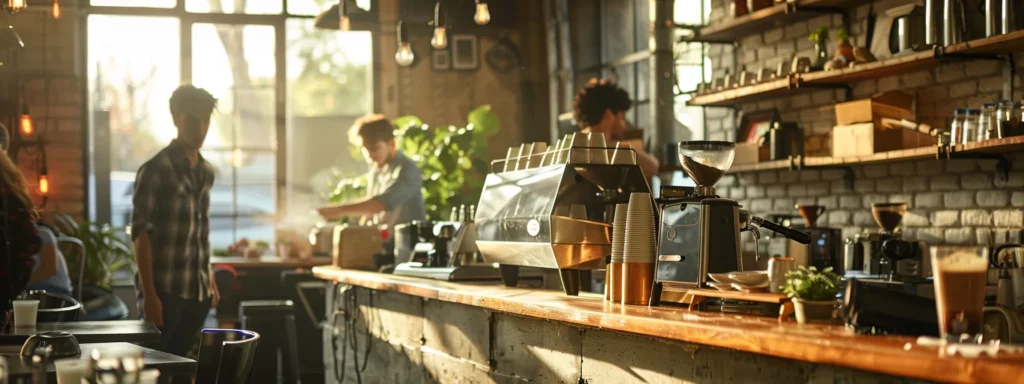
How to Master Barista Skills for Espresso Machines
Are you struggling to create the perfect espresso shot? Mastering barista skills for espresso machines can feel daunting, but it doesn’t have to be. In this guide, readers will learn essential techniques, explore key skills, and discover training programs to sharpen their abilities. By addressing common challenges, this content aims to provide practical solutions for anyone eager to improve their espresso-making prowess. Get ready to transform from a novice to a confident barista, impressing friends and family with every cup!
Key Takeaways
- Mastering espresso extraction is critical for creating consistently great coffee drinks
- Effective milk steaming techniques enhance the overall texture and flavor of espresso-based beverages
- Regular equipment maintenance ensures optimal performance and delicious coffee quality
- Time management in busy coffee shops boosts efficiency and customer satisfaction
- Building connections with peers fosters collaborative learning and improves barista skills
What Are Barista Skills for Espresso Machines?

Barista skills for espresso machines encompass a mix of technical know-how and artistry. Knowing how to operate machines like the Rocket Appartamento requires understanding its components, including the boiler and the extraction process. This foundational knowledge allows baristas to optimize their brewing techniques for a perfect shot.
Creating a great espresso involves mastering the art of tamping coffee grounds. A consistent tamp leads to even extraction, which is crucial for flavor. Baristas should also be familiar with the point of sale systems to accurately ring up orders and manage inventory while maintaining a smooth workflow.
Another essential skill is adjusting grind size and brew time to cater to different beans and equipment. For instance, using a Nanopresso can produce exceptional espresso with the right adjustments. Baristas must be adept at this to ensure they deliver high-quality beverages every time.
Lastly, maintaining equipment is vital in any coffee establishment. Regular cleaning of the espresso machine, including the group head and portafilters, ensures optimal performance. Keeping a well-stocked cart with essentials like cleaning supplies and tools helps baristas stay organized and efficient in their work.
Barista skills are the foundation, but they are only the beginning. Mastering the essential techniques will transform any brew into something exceptional.
Essential Techniques for Espresso Machine Mastery

Understanding espresso extraction is key to crafting the perfect shot, while mastering milk steaming techniques helps create rich, silky foam for lattes and cappuccinos. Choosing the right coffee beans enhances flavor profiles, and knowing the basics of grind size and tamping ensures consistent results. Together, these skills are vital for anyone looking to excel in the hospitality field.
Understanding Espresso Extraction
Understanding espresso extraction is key for any barista aiming to create a perfect cup. It involves finding the right balance of flavors, including the delicate acidity that can enhance the overall taste. For instance, using a well-respected machine like the DeLonghi La Specialista Arte can help baristas achieve that ideal shot, as this model is designed with usability in mind and offers seamless integration of features to optimize extraction.
An effective extraction process leads to a rich, flavorful espresso that serves as the foundation for various drinks, including lattes topped with beautiful latte art. By mastering the grind size and tamping technique, baristas can ensure that each shot flows consistently, much like an assembly line of high-quality beverages, making for a satisfying experience for coffee lovers everywhere.
Mastering Milk Steaming Techniques
Mastering milk steaming techniques is crucial for creating the perfect texture and flavor for espresso-based drinks. A machine like the Gaggia Carezza De Luxe can streamline this process, enabling baristas to produce velvety microfoam that elevates lattes and cappuccinos. Achieving an optimal atmosphere for steaming is about controlling the steam wand’s angle and position, ensuring the milk temperature reaches the right level without scorching it.
Practicing with various machines, such as the Nespresso Mini, can provide different experiences that help refine these skills. Baristas should focus on creating a seamless blend of espresso and milk, which enhances the overall drinking experience. By regularly practicing and adjusting techniques, baristas can boost their confidence and effectiveness, helping them stand out in the competitive world of coffee roasting and service.
Importance of Coffee Bean Selection
Selecting the right coffee beans plays a significant role in achieving the desired taste profile for espresso drinks. Different beans have unique flavors, and finding high-quality options allows baristas to maintain quality control in their offerings. For example, using premium beans with the Delonghi Eletta can elevate the espresso experience, helping to deliver that rich and bold flavor coffee enthusiasts crave, which can also influence a customer’s willingness to spend more at the cash register.
Basics of Grind Size and Tamping
Grind size and tamping are two essential skills that significantly impact espresso quality. A uniform grind allows for balanced extraction, preventing over or under-extraction that can compromise flavor. Baristas who understand how to adjust grind size based on the espresso machine, such as those with a heat exchanger, can enhance their coffee production processes. This knowledge not only improves the taste of the drinks but also enhances customer service, helping baristas deliver consistently great beverages that keep customers coming back.
Tamping is equally critical, as a consistent tamp ensures even pressure on the coffee grounds during extraction. A well-tamped puck leads to a smoother flow of water, creating rich flavors that espresso enthusiasts appreciate. Baristas looking to increase their salary in a competitive industry should focus on perfecting these skills, as mastering both grind size and tamping can elevate their craft. This expertise not only boosts drink quality but also contributes to a strong reputation, encouraging customer loyalty and repeat business.
Espresso mastery requires more than just techniques; it demands skill. As a barista, knowing how to handle the machine is just the beginning of crafting that perfect cup.
Key Barista Skills Needed for Espresso Machines

Developing precision and consistency is vital for crafting drinks like latte macchiatos, ensuring each cup meets customer expectations. Enhancing customer interaction skills fosters a welcoming vibe, while effective teamwork keeps operations running smoothly. Practicing time management allows baristas to serve quality beverages efficiently, and learning to maintain equipment, particularly machines like the espresso machine, ensures optimal performance. Each of these skills contributes to a successful barista experience.
Developing Precision and Consistency
Developing precision and consistency is essential for any barista aiming to create the perfect espresso drink. Each shot should flow smoothly into the mug, ensuring a rich flavor and balanced extraction. Using tools like the right basket for the specific grind size can greatly impact the quality of the espresso, while a careful evaluation of each brew will help baristas fine-tune their techniques for optimal results.
Incorporating effective use of POS systems can streamline the ordering process and allow baristas to focus on crafting high-quality drinks. When making drip coffee or espresso, timing and measurement become crucial; even slight variations can affect the final taste. By mastering these elements, baristas enhance the overall experience for their customers, leading to increased satisfaction and repeat business.
Enhancing Customer Interaction Skills
Enhancing customer interaction skills is essential for baristas looking to create memorable experiences. Friendly conversation can transform a simple coffee order into a connection, making customers feel valued. Whether it’s suggesting a delightful cold brew coffee or explaining the perfect microfoam for lattes, clear communication plays a key role in customer satisfaction.
Using modern tools, like touchscreen ordering systems, can streamline the process and allow baristas to focus on building relationships with customers. Understanding customers’ preferences and providing thoughtful recommendations fosters loyalty, encouraging patrons to return. Emphasizing soft skills not only improves the service but also boosts the overall atmosphere of the coffee shop, creating a welcoming environment for everyone.
Practicing Time Management
Practicing time management is crucial for baristas to ensure smooth operations in busy coffee shops. With the need to consistently prepare beverages like espresso and decaffeinated options, organization becomes a top priority. Understanding the best times to pump espresso shots and steam milk simultaneously can significantly reduce wait times for customers and improve overall coffee preparation efficiency.
Effective time management allows baristas to juggle multiple tasks, from grinding coffee to cleaning equipment and handling orders. Utilizing tools like a convection oven for baking pastries can help optimize workflow, ensuring everything runs seamlessly. By prioritizing tasks and developing a solid routine, baristas can enhance the customer experience while boosting their own productivity.
- Importance of organization
- Understanding how to time tasks like pulling espresso shots
- Managing multiple orders efficiently
- Integrating equipment like convection ovens into daily routines
- Balancing customer service with beverage preparation
Learning to Maintain Equipment
Learning to maintain equipment is key for any barista looking to ensure exceptional coffee quality. Regular cleaning and maintenance of espresso machines, such as the Iperespresso system, can enhance performance and flavor extraction. For instance, checking the group head and portafilters after each busy shift ensures they are free from coffee oils and buildup, which can affect the perception of the espresso’s taste.
Baristas should also be familiar with basic troubleshooting techniques for common issues that may arise. Understanding how to handle malfunctioning parts or knowing when to schedule service can save time and avoid disruptions. Using a dishwasher for daily cleaning of tools and accessories helps keep everything hygienic, making it easier to focus on crafting great drinks and building customer rapport.
With the basics in hand, the journey into espresso artistry begins. Mastering advanced techniques allows one to create flavors that speak, elevating each cup to something remarkable.
Advanced Espresso Machine Techniques

Perfecting barista skills involves more than just the basics. Crafting the ideal espresso shot sets the foundation for all espresso-based drinks. Implementing latte art skills can make each beverage visually striking, while understanding how to optimize machine settings, like those on a Delonghi Dedica or Nespresso Inissia, enhances flavor. Additionally, using sensory analysis can elevate the overall coffee experience, making every cup memorable.
Crafting the Perfect Espresso Shot
Crafting the perfect espresso shot starts with understanding the fundamentals of extraction. Using a machine like the Gaggia Accademia can significantly streamline this process, as its features accommodate precise control over variables such as temperature and pressure. A keen barista pays attention to the consistency of the grind and the tamping technique, ensuring that each shot meets high standards for flavor and customer satisfaction.
The culture of coffee preparation emphasizes the significance of not just the drink, but the experience surrounding it. For baristas aiming to deliver consistently great beverages, regular practice and experimentation with settings, such as those found in various machines, make a difference in quality. Engaging with customers through friendly interactions during an interview or casual conversation can also enhance attention to detail, catering to individual tastes while remaining mindful of the cost of living in their area.
Creating Espresso-Based Drinks
Creating espresso-based drinks requires a mix of technique and flair. Proper training is essential for mastering the use of machines like the Rancilio, which can be quite intricate. Attention to detail in brewing, from the grind size to the water temperature, plays a significant role in crafting beverages such as lattes and cappuccinos.
Baristas should also harness the steam wand effectively, as it is key to achieving that perfect milk texture for espresso drinks. Following a clear job description that emphasizes skills like steaming and flavor balancing ensures a consistent flow of high-quality drinks. This commitment to excellence not only satisfies customers but also fosters a rewarding experience for baristas. Understanding these elements makes all the difference in creating delicious coffee masterpieces:
| Espresso-Based Drink | Key Techniques |
|---|---|
| Latte | Steaming milk to create microfoam |
| Cappuccino | Equal parts espresso, steamed milk, and foam |
| Macchiato | Espresso “stained” with a small amount of frothed milk |
| Flat White | Steamed milk, no froth, combined with espresso |
Implementing Latte Art Skills
Implementing latte art skills can significantly enhance the customer experience at any coffee shop. Using machines such as the Delonghi Specialista or Philips 3200, baristas can create stunning designs with steamed milk, transforming a simple cup of coffee into an artistic masterpiece. Practicing with stainless steel pitchers is essential, as they help control the milk’s texture and temperature, allowing for better pour techniques that result in beautiful patterns like hearts or rosettas.
Knowledge of the intricacies of milk steaming is key to mastering latte art. Baristas should focus on achieving the right microfoam texture, which is crucial for creating a stable base for designs. By honing these skills with different machines, baristas can elevate their craft and impress customers, fostering loyalty and encouraging repeat visits to their coffee establishment.
Optimizing Espresso Machine Settings
Optimizing espresso machine settings is crucial for delivering the best experience to customers. Using machines like the La Marzocco Linea Mini or the Gaggia Cadorna effectively means fine-tuning parameters such as water temperature and pressure. Adjusting these settings not only enhances flavor extraction but also ensures consistency, helping baristas meet the high standards customers expect, especially considering the investment in quality equipment carries a significant price tag.
Different brands have their unique features, and knowing how to use them can make a big difference. For example, the La Marzocco Linea Mini is praised for its robust performance, while the Gaggia Cadorna offers user-friendly controls. By experimenting with these settings and understanding each machine’s capabilities, baristas can create a wide range of espresso profiles, pleasing diverse customer preferences and elevating the overall coffeehouse experience.
With each perfect shot of espresso, the art of coffee becomes clearer. Now, for those who want to master this craft, training programs for aspiring baristas await, ready to sharpen skills and ignite passion.
Training Programs for Aspiring Baristas

Recommended barista certification courses provide foundational knowledge on how to manage equipment like espresso machines and understand water quality impacts on brewing. Practical training exercises, using tools like pitchers for frothing, enhance hands-on skills. Group workshops foster teamwork and knowledge sharing, while individual training allows for personalized skill development, ensuring aspiring baristas gain a comprehensive understanding of roasting, inventory management, and more.
Recommended Barista Certification Courses
Recommended barista certification courses provide aspiring baristas with essential skills needed to master espresso machines and improve coffee preparation techniques. Programs often include practical sessions focused on operating various machines, including lever espresso models, which enhance understanding of the brewing process. These hands-on experiences not only boost knowledge but also lead to greater job satisfaction as baristas become more confident in their abilities.
Courses typically cover important aspects of coffee preparation, such as grinding, tamping, and extraction methods. Participants gain insights into creating the perfect coffee cup, learning how to adjust machine settings for different coffee beans and preferences. Graduates of these programs often find that their newfound skills not only elevate their craft but also open doors to exciting career opportunities within the coffee industry.
Practical Training Exercises for Better Skills
Practical training exercises are vital for those eager to perfect their barista skills. For instance, working with various machines such as the Nespresso Essenza Mini offers valuable insights into espresso extraction and helps baristas practice their technique. Additionally, using a milk frother effectively during these exercises allows for hands-on experience in creating the perfect microfoam, which is essential for lattes and cappuccinos.
Engaging in scenarios that simulate a busy coffee shop environment can enhance problem-solving skills and improve efficiency during peak times. Exercises can also include mastering the French press for those who want to diversify their brewing knowledge. This well-rounded approach not only prepares aspiring baristas for recruitment in the fast-paced coffee industry but also enables them to confidently operate machines like the Philips 4300, providing a solid foundation for their coffee careers.
Group Workshops vs. Individual Training
Group workshops offer aspiring baristas a dynamic learning environment where they can collaborate with peers, share ideas, and develop teamwork skills. This setting is perfect for practicing techniques on machines like the La Marzocco, allowing students to learn from each other’s experiences. Working together also fosters a sense of leadership, enabling participants to gain confidence and adapt to the fast-paced demands of the coffee industry.
On the other hand, individual training provides a focused approach tailored to personal learning styles, with one-on-one attention from experienced instructors. This method allows baristas to dive deeper into specific areas, like mastering the heat settings on their coffeemaker for optimal espresso extraction. By receiving personalized feedback, participants can refine their skills at their own pace, ensuring they are well-prepared to excel in their barista careers.
As baristas hone their skills, they often encounter the challenges that come with espresso machines. Learning to navigate these hurdles can turn a frustrating experience into a rewarding one, making each cup a story worth brewing.
Overcoming Common Challenges With Espresso Machines

Baristas face several challenges when working with espresso machines, including troubleshooting extraction issues, managing milk frothing difficulties, and maintaining equipment properly. Understanding these aspects helps create a sustainable workflow. Enhancing efficiency not only boosts productivity but also helps build rapport with customers by delivering consistent quality. Each of these areas is vital for mastering barista skills and ensuring the best coffee bean experience.
Troubleshooting Extraction Issues
Troubleshooting coffee extraction issues can be tricky but is essential for a great cup of espresso. For example, when using a Rocket Espresso Appartamento, baristas should check factors like grind size, tamping pressure, and water temperature. If the espresso flows too slowly or not at all, it might indicate that the grind is too fine or the tamp is too heavy. Adjusting these variables is key to achieving optimal coffee extraction.
Another important aspect to consider is the quality of the water used in the brewing process. Using tap water may introduce unwelcome flavors that could affect the overall taste of the espresso. Ideally, baristas should use filtered or bottled water for better results, as this can help in achieving the desired flavors and enhance the coffeehouse experience. Staying aware of these details can lead to consistently satisfying results, ultimately making every shot worth the cash spent on equipment and beans.
Managing Milk Frothing Difficulties
Managing milk frothing difficulties can be a common challenge for baristas, especially when it comes to achieving the right texture and consistency. Proper gear plays a crucial role here; having a quality steam wand and understanding how to control the pressure can make a big difference. If the milk isn’t frothing well, it may indicate either too much or too little pressure, so adjusting the steam settings based on your machine type is essential for producing that velvety microfoam.
Another vital factor is the water quality used in the frothing process. Baristas should consider using a water filter to ensure that impurities don’t affect the milk’s texture and flavor. For instance, hard water can lead to buildup in the machine, impacting both performance and the quality of the foam. By keeping an eye on these details and practicing consistently, baristas can overcome milk frothing issues and elevate their espresso-based drinks to a professional level.
Maintaining Equipment Properly
Proper maintenance of espresso machines is crucial for baristas aiming to deliver top-quality beverages. Regularly cleaning components such as the group heads and portafilters can prevent coffee oils and residue from affecting the flavor of each shot. This simple routine boosts the machine’s efficiency and ensures a longer lifespan, helping baristas maintain a consistent standard for their drinks.
A proactive approach to maintenance involves not just regular cleaning but also understanding the specific needs of each machine. For instance, checking water quality can significantly impact both equipment performance and espresso taste. By using filtered water and periodically descaling the machine, baristas can avoid issues that arise from hard water and ensure that espresso extraction remains optimal, ultimately leading to happier customers and a thriving coffee business.
Enhancing Workflow Efficiency
Enhancing workflow efficiency is vital for baristas to manage busy shifts without sacrificing quality. Streamlining the setup of espresso machines allows for quicker transitions between tasks. For example, having all tools and ingredients within reach while preparing drinks reduces delay and creates a more organized work environment.
Implementing a well-established workflow helps baristas tackle peak hours effortlessly. Assigning specific roles in a team, such as one person focusing on brewing while another handles customer orders, keeps operations flowing smoothly. With clear communication and strategic organization, baristas can produce high-quality drinks in less time while ensuring every customer leaves happy:
| Task | Tip for Efficiency |
|---|---|
| Preparing Espresso | Have all ingredients ready and within reach |
| Milk Steaming | Optimize steam wand placement for quick access |
| Cleaning Equipment | Establish a routine for post-shift maintenance |
As baristas master their espresso machines, they begin to see the path to improvement. Building on their skills opens the door to better brewing techniques and customer satisfaction.
Continuous Improvement Strategies for Baristas

Baristas can enhance their skills by actively seeking feedback from peers, which helps in refining techniques and identifying areas for improvement. Staying updated on industry trends is also crucial, as it allows them to adapt and innovate in their beverage offerings. Engaging in barista competitions fosters a spirit of friendly rivalry, pushing individuals to elevate their craft. Joining a community of coffee enthusiasts promotes shared learning and excitement around coffee culture, creating valuable connections that contribute to continued growth.
Seeking Feedback From Peers
Seeking feedback from peers is crucial for baristas looking to improve their espresso-making skills. Engaging in open conversations allows them to gain insights into different brewing techniques and equipment usage, which can enhance their overall craft. For instance, a barista who struggles with milk frothing can benefit from tips shared by coworkers who excel in that area, creating a supportive environment that fosters skill development.
Furthermore, peer feedback can encourage baristas to experiment with new approaches and refine existing methods. Regularly discussing and comparing practices, such as adjusting grind size or exploring various espresso machines, can lead to a more consistent and high-quality beverage experience. By valuing input from colleagues, baristas create a collective knowledge base that strengthens their team and improves customer satisfaction:
| Feedback Method | Benefits |
|---|---|
| Peer Review Sessions | Encourages collaborative learning and sharing of techniques |
| Informal Discussions | Promotes quick, actionable tips in a relaxed environment |
| Training Workshops | Facilitates hands-on learning and constructive critiques |
Staying Updated on Industry Trends
Staying updated on industry trends is essential for baristas eager to enhance their skills with espresso machines. Engaging with coffee blogs, attending workshops, and following influencers on social media can provide fresh insights into brewing techniques and equipment. These resources help baristas stay informed about emerging flavor profiles and popular beverage trends, enabling them to keep their coffee offerings current and appealing to customers.
Additionally, attending trade shows or local coffee events can be invaluable for networking with fellow professionals and discovering innovative tools for crafting espresso drinks. By swapping stories and tips with peers, baristas can learn about the latest machines and techniques, enriching their coffee-making experience. This commitment to continuous learning not only boosts individual skills but also enhances the overall quality of service in coffee establishments.
Engaging in Barista Competitions
Engaging in barista competitions offers a fantastic platform for improvement and skill enhancement. These events challenge baristas to showcase their expertise in espresso preparation, milk steaming, and even creating stunning latte art. Competing not only pushes individuals to refine their techniques but also promotes networking with other passionate coffee professionals who share tips and insights valuable for growth.
Barista competitions encourage creativity, as participants experiment with unique flavor combinations and presentation styles. By participating, baristas gain feedback from judges who are often seasoned industry experts, helping them identify strengths and areas for development. This experience fosters a spirit of camaraderie among coffee enthusiasts, turning an often solitary craft into a collaborative journey of mastery.
| Aspect of Competition | Advantage |
|---|---|
| Skill Showcase | Allows baristas to demonstrate their techniques and creativity |
| Feedback from Experts | Provides constructive criticism to improve skills |
| Networking Opportunities | Connects baristas with like-minded individuals in the industry |
| Inspiration | Encourages innovation and new ideas in beverage preparation |
Building a Community of Coffee Enthusiasts
Building a community of coffee enthusiasts can significantly enhance a barista’s skills and passion for espresso making. Engaging with fellow enthusiasts through local coffee meetups or social media groups allows baristas to share techniques and tips, creating a supportive atmosphere that fosters growth. This collaborative spirit not only inspires creativity but also broadens knowledge about diverse brewing methods and beans.
Participating in workshops or community events also provides baristas with opportunities to connect with industry experts and learn about the latest trends. By exchanging ideas and experiences, they can stay informed on new techniques that elevate their craft. Building these relationships contributes to personal and professional development, helping baristas navigate challenges and take their espresso skills to the next level:
| Benefit | Example |
|---|---|
| Sharing Techniques | Local meetups for coffee cupping |
| Learning Trends | Workshops on new brewing equipment |
| Expanding Connections | Networking at barista competitions |
Essential Key Takeaways for Mastering Barista Skills and Techniques
Mastering barista skills for espresso machines is crucial for delivering high-quality coffee experiences that satisfy customers. By honing techniques such as extraction, milk steaming, and equipment maintenance, baristas can elevate their craft and build a loyal clientele. Engaging in continuous learning through certifications, competitions, and community interactions fosters growth and keeps skills sharp. Ultimately, these efforts result in exceptional coffee drinks that not only enhance customer satisfaction but also contribute to a thriving coffee culture.
